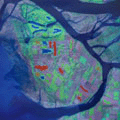|
||||||||||||||||||||||||||||||||||||||||||||||||||||||||||||||||||||||||||||||||||||||||||||||||||||||||||||||||||||||||
|
||||||||||||||||||||||||||||||||||||||||||||||||||||||||||||||||||||||||||||||||||||||||||||||||||||||||||||||||||||||||
| Habitat capability |
|
|||||||||||||||||||||||||||||||||||||||||||||||||||||||||||||||||||||||||||||||||||||||||||||||||||||||||||||||||||||||
|
This application assesses the ability of a defined habitat mosaic (landscape) to sustain waterfowl for a specified period of time. The model was developed to assist the Pacific Coast Joint Venture (PCJV) in assessing the capability of the coastal landscape near Vancouver, British Columbia to support overwintering waterfowl. Brief summary of model framework: PCJVModel simulates the effects of habitat change over time on habitat use by migratory waterfowl species. PCJVModel also performs a sensitivity analysis, allowing you to see how specified changes in input parameters affect output variables. Before running a simulation, you must define the habitat types and species to be included. For each habitat type you must define: For each species you must define: For each migration period you must define: You must also define the time period of the simulation, in years (e.g., 1996 to 2001). Each year in a simulation is divided into 365 days, falling within one of two seasons (summer or winter). A simulation begins on the first day of winter and ends on the
last day of summer (e.g., September 20, 1996 to September 19, 2001).
|
||||||||||||||||||||||||||||||||||||||||||||||||||||||||||||||||||||||||||||||||||||||||||||||||||||||||||||||||||||||||
